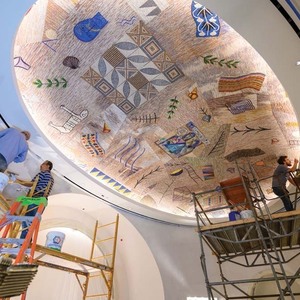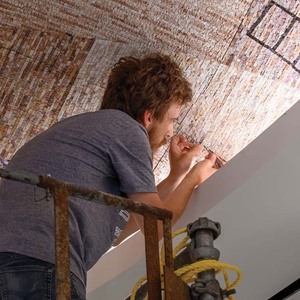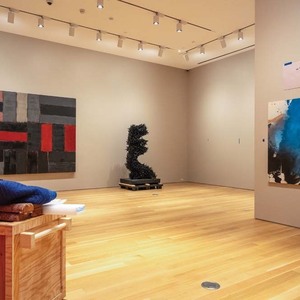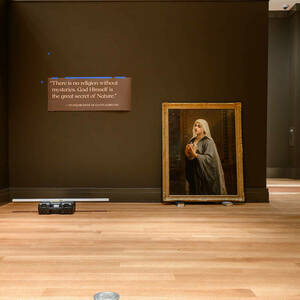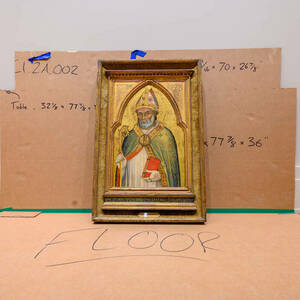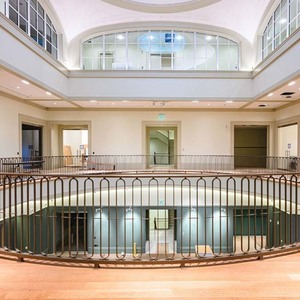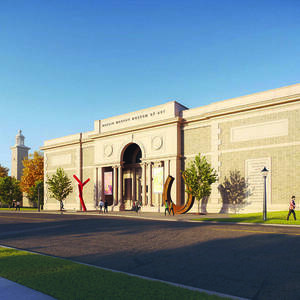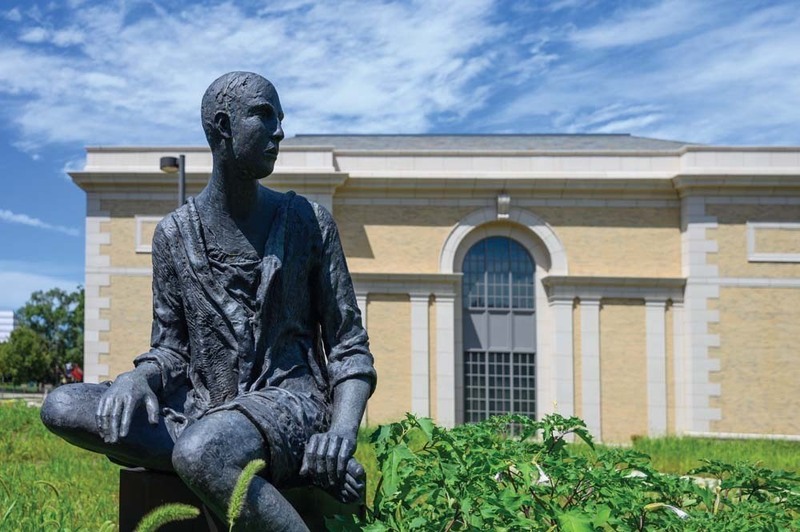 A sculpture, “No. 130 (Observing),” by Hanneke Beaumont, outside the museum. Photo by Matt Cashore ’94
A sculpture, “No. 130 (Observing),” by Hanneke Beaumont, outside the museum. Photo by Matt Cashore ’94
- Snite Moves
- Packed Schedule
- Moving Works of Art
- Museum Pieces
- Divine Inspiration
- Raclin Murphy Readies for Its Debut
Natural light fills the three-level central atrium in the new home of Notre Dame’s art treasures. Nearly two dozen galleries and rooms wrap around the space, a welcoming draw for students, educators, researchers and visitors.
Art lovers on campus and across the region soon will have a fresh venue for indulging their enthusiasm as the University puts the final touches this fall on the Raclin Murphy Museum of Art. The museum is set to open in early December at the south edge of campus, just across Angela Boulevard from Eddy Street Commons.
Preparing to open a major museum is like putting together a jigsaw puzzle with a million pieces. Every little piece must find its place before the job is done. That’s what daily life has been like for months for the museum staff.
The building is designed to offer a dramatic backdrop to works from the University’s art collection, which encompasses nearly 30,000 items. The galleries will feature a wide array of art, including European, American and African pieces, indigenous art from the Americas and international modern and contemporary works.
With 23 exhibit and teaching galleries, an object study room, a sculpture court and a chapel, the four-level museum is designed to serve the academic community and the public. A bookstore and coffee shop named Ivan’s Cafe nods to famed Croatian sculptor Ivan Meštrovic, who taught and worked at Notre Dame from 1955 until his death in 1962.
Some of the galleries feature bold accent walls — bright red, forest green or peacock blue, for example — to enhance the impact of the art on view. The 70,000-square-foot, Beaux Arts-inspired building was designed by Robert A.M. Stern Architects LLP.
The museum staff of about 25 started preparing for the move in May 2022 while going about their work in the former Snite Museum of Art, which closed its doors last April. “We didn’t want to close down one minute earlier than we needed to,” says Joseph A. Becherer, the museum’s director and sculpture curator.
When the new museum opens, visitors will see many favorites long on display in the Snite — including the large 19th-century painting “The Roll Call of the Last Victims of the Reign of Terror” by Charles Louis Lucien Müller and some of Meštrovic’s works.
The dramatic 1891 painting “Absolution Under Fire” by Paul Henry Wood — depicting U.S. Army chaplain Rev. William Corby, CSC, blessing the troops before the Battle of Gettysburg — will hang on the second-level east wall facing the atrium, visible as visitors enter the front door.
Museum registrar Victoria Perdomo and her staff examined and documented nearly 1,000 art objects being readied for the move to the new facility over the summer. Each item was photographed and a description written detailing its age, artist and condition.
A lot of the hallmarks that anchored the Snite will appear in the new museum, Perdomo affirms. “But our curators will also take the opportunity to introduce new items that haven’t been on view.”
“Some of the art hasn’t been on display in decades,” Becherer says. Many works underwent conservation or professional cleaning before being moved. Just inside the entry door of the 18th-century European gallery, for example, are two paintings of the Madonna that had been in storage inside the Snite.
But there will be new art to see, too. Raclin Murphy will feature eight commissioned works by such artists as Jenny Holzer, Jamie Okuma, Kiki Smith and Jaume Plensa.
“Silver Saint Joseph Watershed,” a freshly commissioned work of recycled silver by Maya Lin — the artist who designed the Vietnam Veterans Memorial in Washington, D.C. — will appear on the south wall in the central atrium.
Since early summer, the building has been a hive of activity as workers painted and installed cases, pedestals and other furniture to display art pieces. Paintings were uncrated and carefully hung in their assigned places on gallery walls.
The museum’s Mary, Queen of Families Chapel was designed by Italian artist Mimmo Paladino. The chapel’s sparkling, colorful mosaic ceiling includes images symbolic of the Virgin Mary, Catholic liturgy, the Congregation of Holy Cross, natural history and the native peoples of the region. Paladino also designed the chapel’s large stained glass window and incised wall frescoes. Adjacent to galleries of Renaissance and Baroque Art, the chapel will contain both traditional and contemporary works of religious art.
The new museum is nestled within the Charles B. Hayes Family Sculpture Park, a contemplative expanse of winding pathways that includes native trees and plants and a pond. Several additional pieces of outdoor sculpture have been installed, including George Rickey’s kinetic sculpture “Two Open Triangles Up Gyratory,” “Hot Field Flat” by Sir Anthony Caro and “UPBEAT” by Clement Meadmore.
The Raclin Murphy will become a cornerstone of the University’s arts gateway. DeBartolo Performing Art Center stands to the northwest, Walsh Family Hall of Architecture to the north and O’Neill Hall of Music to the northeast.
The University plans to add a second phase to the museum, nearly doubling its size to provide additional galleries, a works-on-paper study center, more space for teaching and collection storage, and an auditorium.
The Snite Museum, which opened 43 years ago adjacent to O’Shaughnessy Hall, has been renamed the Snite Research Center in the Visual Arts. It will be open to scholars and students by appointment in January 2024. Some of the University’s collection will remain in storage at the Snite, because storage space is limited in phase one of Raclin Murphy.
The museum is named for the families who provided the lead gift for its construction: the late Ernestine Raclin and her daughter and son-in-law, Carmi and Christopher Murphy ’68, all of South Bend. A longtime member of Notre Dame’s board of trustees, Raclin died in July at age 95.
The history of art at Notre Dame dates back at least to 1874, when University founder Rev. Edward Sorin, CSC, hired Vatican artist Luigi Gregori to teach art and decorate the interior of the Main Building and Sacred Heart Church. The University has been planning a new art museum for many years, announcing it as part of a master plan update in 2007. With Raclin Murphy, the future has arrived.
Becherer is mindful of the fact that the days are ticking by on the way to the museum’s opening. “The greatest challenge is to simply stay on track but also to be flexible,” he says. A delayed delivery of some display furniture meant more time to hang paintings, for example.
“Anytime you do a major project like this, if something doesn’t fit, you can’t stop,” the director says. “You have to figure out another way.”
Margaret Fosmoe is an associate editor of this magazine. Read the full series of stories documenting the move from the Snite to the Raclin Murphy at magazine.nd.edu/snitemoves.
